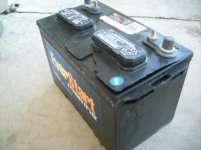Scott Wood
New member
Hi Everyone, I've been reading a lot of other posts about charging and tach problems, and I haven't been able to accurately diagnose my problem.
I bought a 1979 Johnson 140 2 weeks ago (it was attached to a really good boat), it had been sitting for a few years so batteries were dead. I put some new sealed batteries in it and took it out on the water. Motor runs good, everything works well except the tach has not worked since I've had it, the speedo and trim gauges didn't work either so I did consider it a big problem.
But camping on the boat last weekend I ran the first battery flat. I started the boat on the 2nd battery then switched back to the first to charge it and noticed all my lights were still dim and my radio didn't work (obviously not charging). When I got home I did some tests with the engine running and confirmed no charge, I did some tests (as found on this forum) and found the rectifier shorting to ground.
Today I replaced the rectifier, now I have some charge (goes up from 12.3v Engine off to 12.5 Idle and 12.6 at what I would guess is about 3000rpm), still nothing on the tach. The grey wire at the terminal block reads 6.2v with the engine running and the red gives battery voltage. Stator has a resistance of 0.8 ohms between the yellow wires disconnected and no continuity with ground.
So I have these questions:
1. Are the sealed batteries going to cause a problem with the old charging system?
2. What do you think my tach problem is?
3. Will I hurt anything by using the boat again this weekend? I'll run the fridge of a separate deep cycle battery this time and only use one battery at a time?
I bought a 1979 Johnson 140 2 weeks ago (it was attached to a really good boat), it had been sitting for a few years so batteries were dead. I put some new sealed batteries in it and took it out on the water. Motor runs good, everything works well except the tach has not worked since I've had it, the speedo and trim gauges didn't work either so I did consider it a big problem.
But camping on the boat last weekend I ran the first battery flat. I started the boat on the 2nd battery then switched back to the first to charge it and noticed all my lights were still dim and my radio didn't work (obviously not charging). When I got home I did some tests with the engine running and confirmed no charge, I did some tests (as found on this forum) and found the rectifier shorting to ground.
Today I replaced the rectifier, now I have some charge (goes up from 12.3v Engine off to 12.5 Idle and 12.6 at what I would guess is about 3000rpm), still nothing on the tach. The grey wire at the terminal block reads 6.2v with the engine running and the red gives battery voltage. Stator has a resistance of 0.8 ohms between the yellow wires disconnected and no continuity with ground.
So I have these questions:
1. Are the sealed batteries going to cause a problem with the old charging system?
2. What do you think my tach problem is?
3. Will I hurt anything by using the boat again this weekend? I'll run the fridge of a separate deep cycle battery this time and only use one battery at a time?


